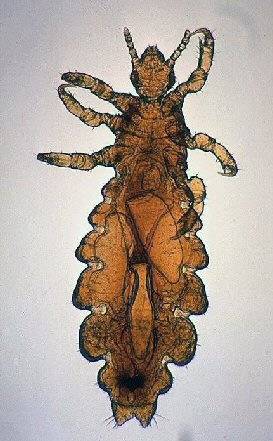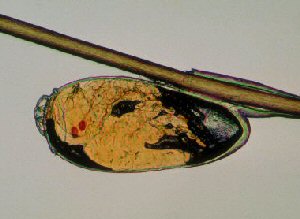Body Lice, Head Lice
 Scientific Name
Scientific Name
Pediculus humanus humanus, Pediculus humanus capitus
Habitat
Head lice prefer to live on the hair of the head although they have been known to wander to other parts of the body. Body lice tend to aggregate where clothing most frequently touches the skin. Body louse nymphs spend the greater part of their time in the clothing, and feeding on the host only takes place when the host is resting or sleeping. All stages of the body louse congregate together, being attracted to each other by smell, e.g., the odor of the excrement. Body lice crawl about the clothing, generally keeping close to the host's body, although in heavy infestations they may be seen crawling outside on the outer garments. Lice are most often transmitted from person to person by direct contact, and they can be easily dislodged from a lousy person onto an uninfested person. They are most often a problem in unsanitary conditions. Simply washing clothes regularly can reduce their abundance.
Life Cycle
 They have a three-stage life cycle: egg, nymph and adult. The eggs of lice are called
nits. They are light tan colored, oval cylinders. The eggs of head lice are glued
to hairs of the head. The favorite areas seem to be near the ears and back of the
head. Body lice glue their eggs to clothing, especially near seams and creases. Female
head lice lay 6--7 eggs per day and may lay a total of 50--150 eggs during their lives.
Female body lice may lay a total of 270--300 eggs in a lifetime. Under normal conditions
the eggs will hatch in about a week. Below 74 degrees F, most eggs will not hatch.
Newly hatched nymphs must feed within 24 hours or die. There are three immature nymphal
stages separated by molts. Their appearance and habits are not greatly different from
those of adults. Both nymphs and adults have piercing-sucking mouthparts, which pierce
the skin for a blood meal. Adults may survive 3 to 5 days without a blood meal. Normally
a young louse will mature to an adult in 3 to 5 weeks.
They have a three-stage life cycle: egg, nymph and adult. The eggs of lice are called
nits. They are light tan colored, oval cylinders. The eggs of head lice are glued
to hairs of the head. The favorite areas seem to be near the ears and back of the
head. Body lice glue their eggs to clothing, especially near seams and creases. Female
head lice lay 6--7 eggs per day and may lay a total of 50--150 eggs during their lives.
Female body lice may lay a total of 270--300 eggs in a lifetime. Under normal conditions
the eggs will hatch in about a week. Below 74 degrees F, most eggs will not hatch.
Newly hatched nymphs must feed within 24 hours or die. There are three immature nymphal
stages separated by molts. Their appearance and habits are not greatly different from
those of adults. Both nymphs and adults have piercing-sucking mouthparts, which pierce
the skin for a blood meal. Adults may survive 3 to 5 days without a blood meal. Normally
a young louse will mature to an adult in 3 to 5 weeks.
Description
The body louse is very similar to the head louse; the body louse is usually 10% - 20% larger, has thinner antennae, not as deep abdominal indentations, with better developed abdominal muscles than the head louse.
Control
Please contact your local county extension office for current information.
